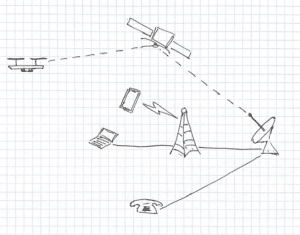Many people would think with today’s IP connected world, satellites would be less important. But reality is quite the opposite. In addition to geostationary satellites providing legacy telcom services, there are many new providers; some with just a few satellites in a world-wide constellation or focused on a particular geographic region and others with hundreds and thousands of satellites. All of these services need to handle many subscribers and provide robust communications in order to earn the revenue to keep them operable. Subscribers need equipment that can accommodate the non-ideal characteristics of the comms links and optimize/reduce their cost.
Communication using satellites imposes a number of constraints and impediments that often make using many standard protocols and algorithms problematic. Issues such as low bandwidth, high delay and large jitter will often inhibit the use of systems that work well over terrestrial networks. And with satellite constellations, communications have to survive satellite handover events as seamlessly as possible. VOCAL has a long history of not only implementing standards-based protocols and algorithms from ITU, IETF, 3GPP, etc., but of also adapting and augmenting these for use in new and challenging environments. We have implemented solutions across a variety of systems from Iridium, Ligado, Lockheed, Inmarsat, Viasat and others.
Speech Codecs
VOCAL implements a number of low bitrate speech codecs that are well suited for low-bandwidth satellite communications. One such coder is MELPe, which can run at low to very low bitrates (2400 / 1200 / 600 bps). VOCAL has implemented MELPe on a variety of platforms for use in low-bandwidth systems. We have also engineered VoIP transcoder systems for the purpose of relaying a standard VoIP terrestrial telephone call over satellite links. In this design, the end user application/configuration is unchanged due to the satellite link, other than being routed through a gateway. The gateway transcodes from a common VoIP codec to MELPe and the far end gateway transcodes back to the original end-to-end negotiated codec. SIP with compression (SIPCOMP) is used to keep the session control traffic to a minimum.
Beyond MELPe, the Tactical Secure Voice Cryptographic Interoperability Specification (TSVCIS) was developed to provide interoperability between waveforms utilizing different vocoder rates, levels of encryption and forward error correction. This codec has a number of advantages for satellite communication. One of the main features of TSVCIS is its bandwidth scalability. TSVCIS can operate in wideband and narrowband modes with data rates of 8000 to 16000 bps for wideband and 600 to 2400 bps for narrowband. Full compatibility with MELP allows for seamless transcoding to match the restricted bandwidth of satellite channels.
Jitter Buffering
Bandwidth constraint is not the only satellite-induced impairment that causes the performance of standard protocols to suffer. Large amounts of jitter, due to transmission scheduling in combination with low bandwidth and high link utilization can also put a strain on systems. VOCAL’s adaptive jitter buffering algorithms for RTP and similar packet-based transmissions is designed to excel in these conditions.
Fax and Data Modem
Other classes of telecommunications – such as fax and data modulations – also have issues with jitter as well as latency. ITU-T T.38, used for transmitting fax over IP, was not specifically designed for the type of delays that satellite can introduce. Additionally, using T.38 over satellite can often have the side effect of adding a second T.38 link (as a tandem T.38) after a terrestrial T.38 service. The ITU design of T.38 did not take any tandem T.38 topologies into account as use cases. VOCAL has designed its T.38 fax over IP systems to augment standard T.38 to combat satellite jitter and delay, and resolve many timing issues introduced by tandem T.38 links. VOCAL’s T.38 remains compatible with other endpoints, gateways and fax machines, while improving performance and robustness of satellite communications – a delicate balance.
VOCAL’s SIP Analog Modem Server (SAMS) and Analog Modem Adapter (AMA) allow M2M modems to communicate on IP networks. VOCAL has used these technologies to allow satellite links to replace standard POTS lines; allowing legacy equipment to be used in very isolated locations, where there is no other communications method available. Additionally, VOCAL’s V.150.1 Modem over IP Gateway allows for transparent in-network conversion of data modem communications to an IP-based data stream that is resilient to high levels of delay, jitter, and packet loss as well as being more bandwidth efficient overall. With its robustness against large round-trip latencies, VOCAL’s modem stack present in its SAMS, AMA, and V.150.1 products, is also capable of terminating modem calls placed over voice-band satellite links.
Session Initiation Protocol (SIP)
Many of today’s satellite solutions use the Session Initiation Protocol (SIP) for session establishment and control. There are times though, when a protocol like SIP is also not ideal for satellite use. VOCAL has used a variety of methods to make SIP systems compatible with satellite transmission. SIPCOMP can be used for compression of SIP to significantly reduce bandwidth. Custom modifications to SIP timing, and minimization of headers has been used to great effect when SIPCOMP is not available for a given the use case. VOCAL has implemented custom SIP to satellite gateways that act as a SIP B2BUAs but with a standard SIP/RTP network on one side, and an extremely minimal configuration on the other. The satellite side is designed using low-bitrate codecs and custom signaling that uses only a few bits for signaling.
Custom Engineering
In addition to our already existing technologies for satellite, VOCAL offers custom engineering and design services for satellite a wide variety of communications systems. Our highly experienced communications engineers can design systems to meet your requirements using our existing licensed components as well develop new technologies to solve your satellite communication problems.
Platforms
![]()
VOCAL’s optimized software is available for the following platforms. Please contact us for specific satellite solutions and supported platforms and performance data.
| Processors | Operating Systems |
|---|---|
|
|
